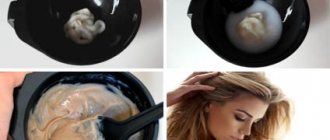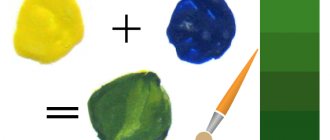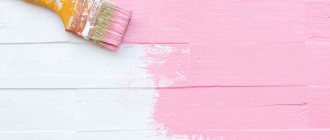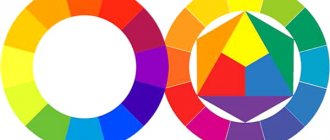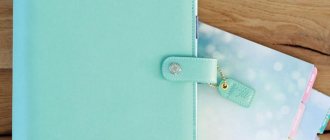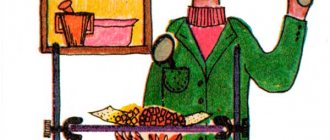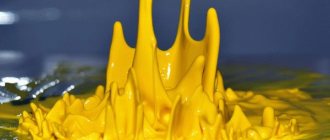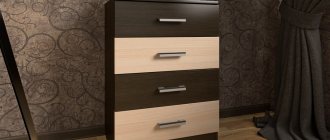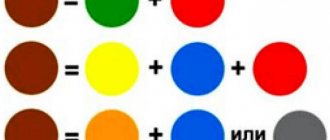How to get blue from different colors
So, you can't get pure blue by mixing other colors, but you can achieve new interesting shades of azure by combining blue with other colors.
Expert opinion
Zakharova Irina Yurievna
Cleaning professional with 15 years of experience. Our best expert.
Ask a Question
Important: the more main coloring pigment in the mixture, the closer in tone the resulting shade will be. The less the original colors are mixed, the purer and brighter the shade turns out. It is not recommended to mix more than 3 tones.
Green
When blue and yellow are mixed in equal proportions, green is obtained. Adding a drop of green to the base tone produces a turquoise blue hue, which can be made lighter by adding white. By mixing blue, green and black, you can get different shades of dark blue. For example, royal blue or dark blue.
Yellow
Mixing yellow and blue paints produces different shades of green. A drop of yellow into a blue base creates a blue-green tint. Mixing blue with bright yellow provides tones ranging from green and turquoise to olive and light green.
Red
Adding red to the base tone produces different shades of purple and violet. Mixing blue and pink produces lilac or purple. When red, blue and yellow pigments are mixed in equal proportions, a black color appears on the palette.
Step-by-step instructions for getting blue
In order not to lime excessive amounts of paint and varnish material, you need to know the rules for mixing colors. You shouldn’t add a lot of new paint at once, so as not to create an unnecessary tone or make it too bright. It is possible to correct the saturation by using white, but it is still better to immediately purchase the necessary colorful material.
You shouldn’t add a lot of new paint at once, so as not to create an unnecessary tone or make it too bright.
Necessary materials
The tinting process does not require many materials and tools. It is important to decide on the type of paint product in order to purchase the right shades for the same type of job.
Wooden tools are used to stir the liquid. You can use brushes, but make sure that the bristles are well attached to the main part, otherwise they will fall into the paint and create defects on the base when painting.
It is optimal to use a drill for materials for finishing work, on which a special attachment is installed for stirring the compositions. A construction mixer is also used for this purpose, which will allow you to get a homogeneous mass quickly.
Among the coloring agents, it is recommended to have white and black, which will help darken or lighten the result if necessary. It is also necessary to prepare several containers, preferably plastic, the material does not cause a chemical reaction with coloring agents.
A construction mixer is used for this purpose, which will allow you to quickly obtain a homogeneous mass.
Paint selection
You can choose different types of paint and varnish products. There are different formulations on sale that differ in technical characteristics. Accordingly, a choice should be made taking into account the operating conditions.
You should carefully study the manufacturer's instructions before work to learn the nuances of using paint.
It is taken into account that when covering different surfaces, the shade may look slightly different, so designers often decide to carry out tinting during work in order to achieve the desired coloring. For this reason, it is worth starting to paint only a small area in order to evaluate the result in advance.
A popular choice is acrylic paints, which are distinguished by their brightness. Previously, oil types were often chosen due to the lack of product variety and their characteristic strong odor.
A popular choice is acrylic paints, which are distinguished by their brightness.
Preparation and main process
When the tools and materials are prepared, they look at the base, which will then be coated with paint. You need to get a clean and grease-free surface so that the layer lays evenly. The steps to obtain the desired shade of blue are as follows:
- The blue base is poured into a clean container, it is better to use a small amount at first to carry out a test mixture;
- Afterwards, the color chosen for the work is gradually introduced, the mass is thoroughly stirred to evaluate the result obtained, and if necessary, a second paint is added;
- After you have achieved the desired option, you need to evaluate the effect by painting the base;
- The final result is obtained only after complete drying, so wait for this moment.
It is recommended to carry out the assessment in different lighting conditions - daylight and artificial light. And the ratio of funds is recorded so that the combination can be repeated if necessary.
Stir the mixture thoroughly to evaluate the result obtained; if necessary, add a second paint.
Classic blue and its shades
You won’t be able to make blue at home, so to create different shades of it you need to purchase ready-made gouache, watercolor, acrylic paint or another type of dye (even plasticine). Then you can use other colors from the set, because when they are combined you can get incredible tones and halftones of blue. Artists have special tables with the names of shades and the required proportions for paints, but in practice they still have to experiment.
In regular gouache sets, blue is represented by the shade ultramarine. It is very bright, moderately dark, and has slightly purple notes. There is an important rule that you need to remember: add white to lighten the tone, black to darken it, and different colors to change the reflection of the paint.
Read also: Mashed potatoes without milk -
Blue-green
Making shades of blue with green highlights is easy. The effect of a dark green tone is achieved by introducing a small amount of ready-made green paint into the blue. If it is not there, you can do it differently. Since the combination of blue and yellow gives a green color, you can add a little yellow to the blue. Next, the paint is lightened with white, the result is a third-order shade, less saturated.
Prussian blue
The azure color also contains green shades. Artists have a recipe for its preparation - you need to combine 1 part blue and the same amount of light green or bright green (grass) shade. If necessary, the tone is diluted with white.
Blue-violet
This color is considered very rich and powerful in energy; it is prepared by combining blue with red paint in equal proportions. But the finished purple must be made to turn blue, for which blue color is added drop by drop until the desired tone is obtained. Typically the final ratio does not exceed 2:1.
Shades of blue
Blue is the ancestor of many other colors: green, purple, brown, and is also one of the main three RGB colors:
| Decoding | Translation |
| Red | Red |
| Green | Green |
| Blue | Blue |
The blue tone is found everywhere. Natural dye can be made from natural objects.
For example, blue dye is obtained from:
- blackberries;
- eggplant;
- plums;
- blueberries
However, this production method is very labor-intensive, so it is not very popular. On an industrial scale, blue paint is produced chemically using natural salts and metals. For example, cobalt salts and aluminosilicates produce magnificent shades from the lightest to the darkest tones.
Almost all paints sold in stores were obtained chemically. Like any other primary color of the seven, blue has a huge variety of shades. Our eye can distinguish hundreds and thousands of colors close to blue.
The main shades that are found in paints include:
- ultramarine;
- blue;
- cobalt blue;
- azure;
- blue spectral;
- cornflower blue is an unusual shade of blue, which got its name after the flowers whose petals have this particular color;
- indigo - if the color contains a little dark blue and a little violet. It was also named after the plant. However, unlike cornflowers, it is not found here. Indigo grows in India.
There are about 200 shades of blue in nature.
Its tones are visible in:
- sea water;
- twilight;
- moonlight.
They are also present in many insects. Our eye perceives any wavelength from 440 nm to 500 nm as blue. Everything below 440 nm is violet, and everything above 500 nm is green.
There are also many variations of these shades from lightest to darkest. Such paints help create a wide palette: you just need to add other colors.
Important colors are included in the “color wheel.” This is the name of a model divided into sectors. They exist in an order that approximates the visible light spectrum. Shades that are adjacent to each other are called chromatic. When they are mixed, new chromatic tones are obtained.
If you mix shades located far from each other on the “color wheel”, you will get an achromatic color (not colored, but grayish).
Brown
Depending on what base color you need, combine:
- Green with red pigment;
- The same bright red shade with yellow and blue;
- Yellow paint with white, black and red;
- Mix orange with blue or gray.
Variations of brown are created as follows:
Mustard
A yellow paint pigment combined with red, green and a small amount of black;
Medium brown
Add red and blue to yellow paint, lighten with white, and darken with black;
Beige tone
It works if you gradually add white to brown, and then create brightness using yellow;
Creating a classic shade
Unfortunately, no matter what components are mixed, without the primary tone itself it will not be possible to even come close to creating the required shade .
Red and yellow colors follow the same rule.
If the color in your palette is too dark, then white paint will help to lighten it a few tones.
If, on the contrary, you need to darken the shade, then you need to add more dark tones to the mixture - black, gray or brown.
Important!
If you are mixing colors to create a small pattern in the interior, then you can mix them in a small bowl by hand. If you want to paint an entire wall, tint the ingredients in a bucket using a mixer.
This is interesting! What is anthracite color? How to get it. Anthracite color combination in the interior.
Primary and additional colors
How to make a color wheel
The color wheel is a tool on which you can visually construct all significant color schemes. Colorists, artists and designers need a paint mixing table and a color wheel in their work. He can help the child with his first acquaintance with flowers, and will also explain how to combine gouache or plasticine himself, getting something new.
You can create such a combination tool yourself:
Using a compass, draw a circle of the desired radius on paper. Without a compass, you can also circle any round object without going beyond the boundaries of the sheet. Step back from the main circle and draw another circle inside, half the size of the first. Next, draw an equilateral triangle in the inner circle. Divide the triangle into three parts by drawing perpendiculars from the middle of each side to the center.
On the inner circle, place points opposite all the perpendiculars, connect them together with the vertices of the triangle. Draw 12 equal sectors between the circles. Take three basic tones: blue, yellow, red. They will fill the internal sectors of the triangle and the sectors in contact with its vertices. It is better to use gouache to fill the circle.
To fill in the rest, simply mix gouache in equal parts and fill the part of the circle located between them, as well as the sector opposite. At this stage, you will paint over the sectors one at a time. Next, we take a first-order pigment (the top of the triangle) and a second-order pigment (the top of the hexagon) and fill the sector between them.
Let's add green
There is no clear answer to the question of what colors to mix to get blue-green. It all depends on the proportions. Eg:
- For 2 parts blue we take 1 part green, we get blue-turquoise;
- equal amounts of blue and green - the result will be turquoise green;
- the proportion is 0.5:1 - the result is green-turquoise.
Now let's talk about how to make a bright blue color. Let's add light green (one of the shades of green) to it. The result is Prussian blue. In this case, the blue will become more intense. Thus, by combining shades of the input tone, you can get many transitions.
How to get a classic blue color when mixing paint?
Even in a set of 12 shades, you may not have the classic blue paint, the so-called royal shade. For example, in acrylic paints the main blue color is ultramarine: a very bright and dark shade with a slight purple undertone. To obtain a lighter blue paint, mix it with white: 3 parts blue and 1 part white. The more white, the lighter the tone, up to a sky blue hue.
And to get a moderately saturated tone, dark saturated paint should be mixed with turquoise.
Computer graphics and basic palette
It is possible to create blue color under so-called “artificial conditions” without any problems. Even though it is basic, a specific condition can be found. The software provides the ability to synthesize any color using a correctly written binary code.
Unlike typography and artists, programmers do not face the problem of obtaining the main color to obtain this base. The main thing is to choose the appropriate software environment.
Basic shades
In addition to cyan (light blue) and azure (dark blue), common tones are cornflower blue (with the addition of purple and red-brown), royal blue (with an admixture of green), and blue-gray. You can also note turquoise with an admixture of green or yellow, lavender, which has a purple tint.
But artists continue to experiment, adding microscopic fractions of other colors to this pigment. The result is stunning. Few people have heard of a tone called “Evening Color” with the addition of gray. Or about the "Purple Impression". There are shades of “Silver Lake”, “Fortress”, “Niagara”, “Adriatic”.
For now, we will learn how to create classic shades of blue. Having understood the essence, in the future you will be able to obtain any of its tones.
Features of obtaining different shades
Let's try to get different variations based on a pure tone.
See also
Types of viscometers for paint, how viscosity is measured and how to determine it
Blue
White should be added to blue until the desired shade is achieved. If you need a very light tone, it is better to do the opposite, adding blue to the white drop by drop.
Cornflower
To get this shade, artists advise adding purple to the main one and a drop of red-brown and black.
Thunderstorm
Mixing azure and brown or gray gives just such a shade. To make it lighter, add white if necessary.
Sapphire
A very complex color, because the gemstone that gives the color its name can range in color from blue to almost black. Adding a drop of pink color to the base will ensure the appearance of a sapphire hue on the palette.
Cobalt
Cobalt blue in sets of art paints is the same basic color from which all the others are obtained. Cobalt dries quickly and covers the surface perfectly.
Yellow and orange
Summer landscapes cannot be imagined without these shades.
Eggshell color
It can be conveyed if you add yellow and a drop of brown to white paint;
A realistic skin color is achieved by a yellow-brown tint with the addition of a large amount of white.
Oil dyes
Oil paints are mixed in three different ways:
- By combining several different shades.
- Applying several shades of colors one on top of the other. The bottom color can be brighter and more saturated. The surface layer can be made translucent .
- You can apply several strokes to the work surface sequentially one after another. This way you get the effect of a different color.
Oil dyes differ in depth and density. And although these materials are somewhat more expensive compared to others, they are well worth the price.
Green
Created by adding yellow and blue paint. The saturation of the resulting tone depends on the amount of the first or second shade.
Khaki
Khaki is based on green and brown. And you can get it by mixing yellow-orange with blue-green or blue-violet tone.
Synthesis in typography
This method is used in modern printers. It is believed that in printing, blue can be obtained by mixing green and one of the shades of purple - fuchsia. Naturally, a pure basic one will not work, but only an analogue close to the original.
In the field of typographic work, the lack of quality in color saturation is improved artificially, using the play of shades and contrast. Using a standard color wheel, you can also recreate shades. How to make a high-quality analogue can be answered by a highly qualified specialist using the trial and error method. In any case, there must be a basic tone, which, when mixed, will become the basis for creating your own interpretations.
Not only the palette for creating color is taken into account, but also the characteristics of the surface on which the tone will be applied. First you need to take a sample and test it.
How to achieve a purple hue
There are two options here. You can add pink color. Don't forget about proportion. It is equal to 3:1. Before us is royal ultramarine - the tone of night blue.
Let's take mangento pink as a base. The result will be simply magnificent. The royal blue has a hint of azure.
Let's try replacing pink with purple. The latter will take on a cold tint. This tone is called ultramarine.
Blue color in everyday life: useful tips
If you are experimenting with colors when making renovations, then take into account not only the resulting shade, but also what surface will be painted with it. Therefore, be sure to try on a small area the color created by your imagination.
- A tip for housewives who love to cook unusual, bright dishes: for blue notes in your culinary masterpiece, you can safely use blackberries, blueberries, blue grapes and even eggplant peel.
- Natural blue dyes are among the rarest. How many blue pigments can you remember, besides lapis lazuli? What about precious stones other than sapphire?
Dyes
But this mysterious color, depending on its saturation, can create diametrically opposite effects.
So, if you want to get favorable terms of the deal from your partner, conduct negotiations surrounded by light blue, which helps you focus on the main thing. And many psychologists say that wearing blue clothes makes people calmer.
Tips for Mixing Colors
To obtain the ideal color, you need to ensure that all ingredients are similar in chemical composition. Otherwise, the mass may separate, leaving unmixed veins. It is also important to use high-quality paints, because others begin to darken and turn gray over time. Oil dyes are very susceptible to changes - it is better to first try the work on a small area and evaluate the effect after a couple of days. Artists note: the fewer colors were combined, the better the result will be, and the lower the risk of fading and peeling of the finished decor.
Useful video: how to mix colors
Combine combinations of warm shades with delicate pastels, blue tones with cold ones. Change the proportions to your liking; proper tinting is the key to successful repairs. Experiment and create your own color scheme!
three red blue red in red or red tint red proportions red and part of red and red to get the one you want you can get a lot of shades are obtained by to get brown how to get brown dilute with white more white &ndash white yellow white color added white and white color
commentsarticlesauthorinformationinteriorsharesiteoftentypesadditional wayslinksbacksourceyearcontactfacebookodnoklassniki

